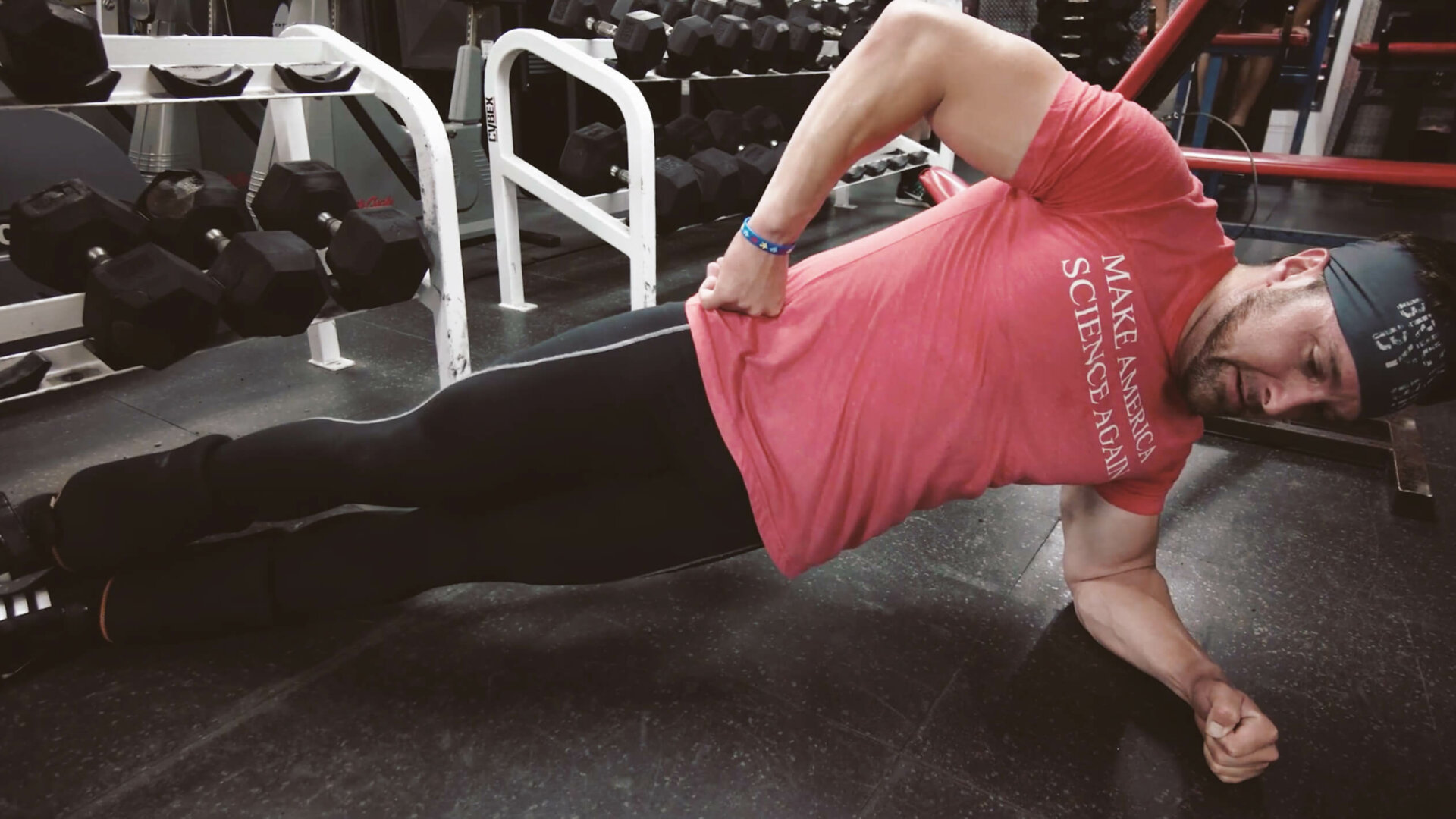When you think of “the core” and the training of it, what do you think of? By virtue of you being here, you fall into the “I don’t need to do direct core work because I squat and deadlift 97% of the time I set foot in the gym” camp. As a result, when you do think of core training, you think of people doing crunches, or some type of spinal extension exercises and mock them.
In reality, core training is fairly simple if you think about it. Before we go further, I will define the core as your spine and pelvis. The center of you, if you will. The main thing to consider is this: most gym and sport activities require the core to be stable in some or all directions. Stability is the ability to resist movement. The MMA fighter who over extends her punch and loses her stability gets knocked off balance, and knocked down. The deadlifter who loses her core stability under heavy load hurts her back at worst, or fails the lift at best.
Stability Matters
I like to think of all the core stability exercises as regressions for the main activity you intend to engage in. Simply telling an athlete—who may have different degrees of kinesthetic awareness and knowledge—to “engage your core” misses the mark. More so when applying this to a sports specific context. In terms of our hypothetical MMA athlete, performing a punch properly is contingent upon moving the legs and arms just enough for the punch to work, and keeping the spine stable enough to keep the balance.
What is the solution? Core stabilization in easier contexts that we can vary over time and apply to other contexts. That being said, the most familiar place for us to start is with the plank. In short, the plank is a full body anti-extension exercise that strengthens the abs and helps us practice tension everywhere else, as taught by Bret Contreras in this video. The takeaways are as follows:
- Don’t let your middle dip like a sagging bridge
- Squeeze your glutes to help posteriorly tilt your pelvis
- Don’t look up, look at the ground
- Keep all that in mind to keep the spine neutral
Once you have that, people often hold the plank for time and subsequently increase the time. And there is a good reason to enforce this position and burn it into your brain. Ideally, if you look at the end portion of a deadlift, squat, or a good morning, as well as the entirety of a pushup, the position should look familiar to you. It should look like a plank. Ideally, in a squat, deadlift, or good morning, you keep the upper body position the same as you would in the plank in all portions of the lift—braced abs and neutral spine—and when you end the lift, your upper and lower body resemble the plank. Obviously, hand and arm position will differ, because you have to hold the weight, but the core, that is the pelvis and spine, will have the same position as the plank. So with that in mind, the basic plank is excellent for reinforcing that particular pattern of stability. In short, before you start moving, you have to learn to not move.
Once you learn how to stabilize your core in that context, you have other contexts in which you can do the same. Schoenfeld and Contreras have a nifty little table going over a litany of them (see the references) but a few of them bear mentioning here:
- For anti-lateral flexion, you have suitcase holds and side planks
- For anti-extension you have the plank and the push-up
- For anti-forward flexion you have deadlifts, good mornings, and squats
And others mentioned and many more they don’t mention.
So these are good starting points. Practice them all. You might notice some sides of your body are more difficult than others, and in practicing this way, you’ll tighten up any glaring weaknesses in your sport or in your lifts, which means you can progress to make the exercises more difficult all around.
The Spine Shall Endure
We know through countless studies that core stability can help improve lower back pain in the short term. In fact, one particular meta–analysis confirms this:
From the 28 potentially relevant trials, a total of 5 trials involving 414 participants were included in the current analysis. The pooling revealed that core stability exercise was better than general exercise for reducing pain [mean difference (−1.29); 95% confidence interval (−2.47, −0.11); P = 0.003] and disability [mean difference (−7.14); 95% confidence interval (−11.64, −2.65); P = 0.002] at the time of the short-term follow-up. However, no significant differences were observed between core stability exercise and general exercise in reducing pain at 6 months [mean difference (−0.50); 95% confidence interval (−1.36, 0.36); P = 0.26] and 12 months [mean difference (−0.32); 95% confidence interval (−0.87, 0.23); P = 0.25]. [2]
But there is some emerging research that can help us look at back pain in a more specific scope. The research is on core muscular endurance. And one of the ways to assess that is using Dr. McGill’s endurance test. And that was the basis of one particular study that noticed the association between non specific back pain and collegiate athletes. [3]
Of course, with only 55 people in the study, there is room to improve, but from a standpoint of training, there’s no reason you couldn’t add more core endurance into your program, especially if there is a chance that it will help you reduce future injury.
Having said that, the easiest way to add more endurance work to your core stability work is to increase the time performing them. For instance, going from a 30 second plank to a 90 second plank is a definite increase in muscular endurance. But at what point is it diminishing returns? How long do you want to plank for? I mean you eventually have to train, right?
Thankfully, we have options. One of those options—and a good way to take a broad array of exercises and make them a bit more specific—is to add movement to our core exercises. With that in mind, the core stays stable, but one or more of our extremities will be moving. Or, they come in the form of higher rep versions of our basic lifts. So here are a few of my favorites:
The Kettlebell Swing
This might seem like a fad, but there is a reason it is wonderful. It reinforces proper deadlift form, since the movement itself is a hinge. But, since heavy kettlebells are a rarity (most go up to around 100lbs) they’re a great way to practice endurance in that hinging position. Important notes: if your spine starts to badly hyper extend, stop swinging. Ideally, stop swinging before you feel your form degrade. For more details, see the references.
Elevated Knee Tucks
These, as you can see in the embedded video, start off as a plank with your feet on the wall. So, to maintain that position, you create isometric tension by moving your hands forward and squeezing your glutes. From there, control the movement and tuck your knee and bring it forward. Alternate legs while maintaining the proper alignment. A good starting point is about five tucks per leg, and you can progress from there. To make it easier, elevate your feet higher. To make it more difficult, lower your foot positioning on the wall.
Dimel Deadlift
This is akin to the kettlebell swing. However, it’s more specific to the deadlift because you actually use a bar, and it’s pretty easy to do. So what is a Dimel Deadlift? It’s a partial deadlift starting at the knees, performed at a fast pace for high reps. That simple. Maintain your normal deadlift form, and start with sets of 15 and work up to sets of 20.
Side Plank with hip abduction
Just like the regular side plank mentioned above and in Schoenfeld’s chart in the references, we are simply adding in hip abduction of the free foot. To perform properly, squeeze your glutes hard, so you can maintain your proper alignment. As you can see from the video, it’s pretty tough. Just like with the knee tucks, start with five per side and work up.
Conclusion
So there we have it. Four exercises to increase both endurance and stability within the context of movement. There is one thing I can’t stress enough. My coach Frankie Faires is fond of saying “you get better at what you do and how you do it.” With that said, stop your exercises before your form degrades, if you can. It is an acquired practice to predict these things, but over time, you will become aware of the sensations you experience before and during form degradation. So be aware of them. You want to perform all these core exercises crisply and with excellent form.
And as always, use less range of motion to scale some of these back, or add more to make them difficult. Experiment with angles and leverages and speed, as well. But only make them as hard as they need to be for you to complete the reps with good form.
References
- Schoenfeld, B., & Contreras, B. (n.d.). Strategies for Optimal Core Training Program Design. Retrieved from https://bretcontreras.com/app/uploads/Strategies-for-Optimal-Core-Training-Program-Design.pdf
- Wang, X., Zheng, J., Yu, Z., Bi, X., Lou, S., Liu, J., . . . Chen, P. (2012). A Meta-Analysis of Core Stability Exercise versus General Exercise for Chronic Low Back Pain. PLoS ONE,7(12). doi:10.1371/journal.pone.0052082
- Abdelraouf, O. R., & Abdel-aziem, A. A. (2016). THE RELATIONSHIP BETWEEN CORE ENDURANCE AND BACK DYSFUNCTION IN COLLEGIATE MALE ATHLETES WITH AND WITHOUT NONSPECIFIC LOW BACK PAIN. International Journal of Sports Physical Therapy,11(3), 337-344.
- McGill, S. Low back stability: From formal description to issues for performance and rehabilitation. Exercise Sport Science Review 29(1): 26–31, 2001
- Baker, P. (2017, January 24). Kettlebell Swing. Lecture. Retrieved from Video of me explaining the kettlebell swing

